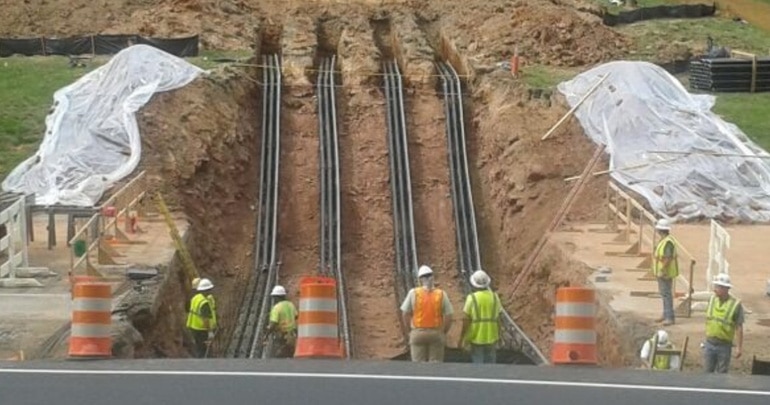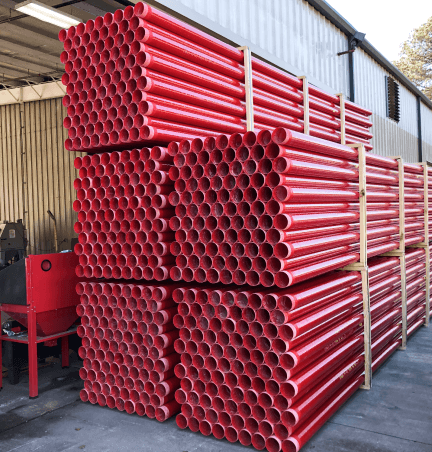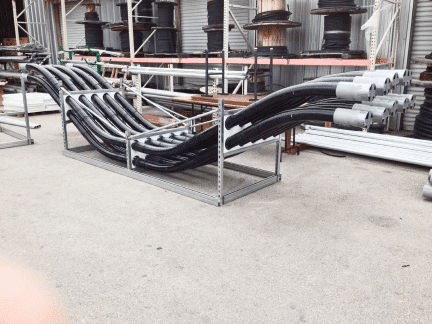In case you had not noticed, there’s been a lot of utility infrastructure talk in the news this year. Whatever the prompts — windy weather events like hurricanes in Florida and Louisiana and wildfires in California, freezes in Texas and even electric vehicles — there is no doubt that the aging electrical grid needs updating for sustainability and efficiency. SPG Global reports that upgrades could include, “thousands of miles of new transmission lines to accommodate the addition of renewable energy.”
Electrical conduit is an important part of utility upgrades as it protects cables and wires including transmission lines buried underground. Buried utilities have also been used in city light upgrade projects in which cities also get the advantage of a cleaner look, with no overhead power lines. But an urgent need to bury transmission lines was felt most recently in California.
Again this summer, wildfires continue to rage there. With AccuWeather forecasting 9.5 million acres of land to burn this season across the already drought-stricken western U.S., they are a serious public safety concern.
According to KRON4, PG&E, the nation’s largest utility company, has told regulators that the Dixie fire may have been caused by trees toppling onto its power lines near the town of Paradise. (Dixie is the largest of nearly 100 major wildfires burning across the Western U.S. and Alaska, mostly instigated by high temperatures, strong winds and dry weather.)
As the Dixie fire continues to burn, PG&E has said at times it might cut electricity to 40,000 customers in an effort to prevent wind gusts from damaging lines and sparking fires.
Why bury utilities like transmission and power lines?
For wildfires like Dixie sparked by dry vegetation near transmission lines, there is a better solution instead of blackouts. Buried utilities, that is, encasing high-voltage transmission lines underground in electrical conduit, protects dry vegetation from errant sparks and helps minimize disruptions to the economy, public health and safety.
The utilities are getting the message. In a surprising recent reversal, the Wall Street Journal reported that, “PG&E Corp. plans to bury 10,000 miles of power lines to reduce wildfire risk throughout Northern California at an estimated cost of up to $20 billion.”
How deep are utility lines buried?
Typically, the depth of the burial depends on many factors including location, weather, local utility requirements and project specifications such as whether the conduit will be encased buried or direct buried.
That said, the National Electric Code (NEC) sets the required burial depth of electric wire in rigid, non-metallic conduit at 18 inches, which keeps it safe from being severed or disturbed. Trenches holding larger duct banks can even reach 10 to 12 feet in depth.
What’s the best electrical conduit for buried utilities?
From galvanized rigid steel to PVC to rigid metal conduit, there are many types of electrical conduit to choose from for below-ground installations of buried utilities. But none possess the benefits and safety for underground utility environments that durable fiberglass conduit offers.
Fiberglass electrical conduit protects critical infrastructure because of it’s high dielectric strength. In fact, UL-listed Champion Fiberglass conduit has a dielectric strength of 55o volts and with our XW wall thickness of 0.25″ it can carry transmission lines up to 125 KV (or more if wall thickness is increased).
Further, it offers low coefficient of friction so fewer pull boxes are required. Plus, with resistance to electrical faults, the electric wire does not melt or weld to the conduit facilitating easy repairs.
Even more, our electrical conduit installs safely and seamlessly with smooth handling in the field and no need for special tools, so it saves time and money in installation.

Perhaps most importantly, it is available with shorter lead times and lower prices and not subject to the current PVC conduit shortage.
In addition to meeting underground electrical code requirements like dielectric strength, low coefficient of friction, and fault resistance, consider these additional benefits fiberglass conduit provides for not just buried utilities but also data center projects:
- Fault resistance – fiberglass conduit is resistant to electrical faults. Should one occur inside a fiberglass conduit, the affected (faulted) cable just needs to be removed and the fiberglass conduit duct can be re-used instead of being replaced or using a conduit spare as with traditional conduits.
- It protects underground utility lines and electrical wire with the broadest range of corrosion resistance compared to other underground ducting products. The conduit is resistant to many chemicals.
- To safeguard against extreme weather conditions, the temperature range of fiberglass conduit is a broad -60℉ to 250℉.
- Excellent shape retention prevents impact or compression of conduit encased in concrete.
- Fiberglass elbows are resistant to cable burn-through thereby speeding up the installation and eliminating damaged conduit.
- Rodent-proof fiberglass conduit provides protection from animals digging near trenches.
- Electrical conduit manufacturer Champion Fiberglass has the lowest NECA man/hour installation rates of any material type of conduit sized 1 1/4“ and above.
Innovative Solutions for Buried Electrical Utility Infrastructure
Check out this case study where the Champion Fiberglass conduit system provided a solution in a buried application for an Indiana utility. For this project, the distance between the concrete vaults was extended from every 250 feet using SCH80 PVC up to every 750 feet when using fiberglass conduit through the duct bank, due to fiberglass (RTRC) conduit’s extremely low coefficient of friction. This resulted in approximately $3 million in cost savings.
Finally, get more information, specs and frequently asked questions about below ground applications of Champion Fiberglass conduit, such as NEC code requirements for underground conduit, in our below ground applications guide.
Keep Reading
Champion Fiberglass® Named a CompositesWorld Top Shop for 2024
The origins of fiberglass date back to the ancient Greeks. Today fiberglass is used for a variety of applications from…
Get to Know Research and Development Engineer Blake Rogers
He’s got a diverse background in engineering, is new to Texas and can juggle. Meet Blake Rogers.
Electrical Conduit Cost Savings: A Must-Have Guide for Engineers & Contractors
To help identify cost savings that don’t cut corners on quality, Champion Fiberglass developed a free resource for engineers and…










